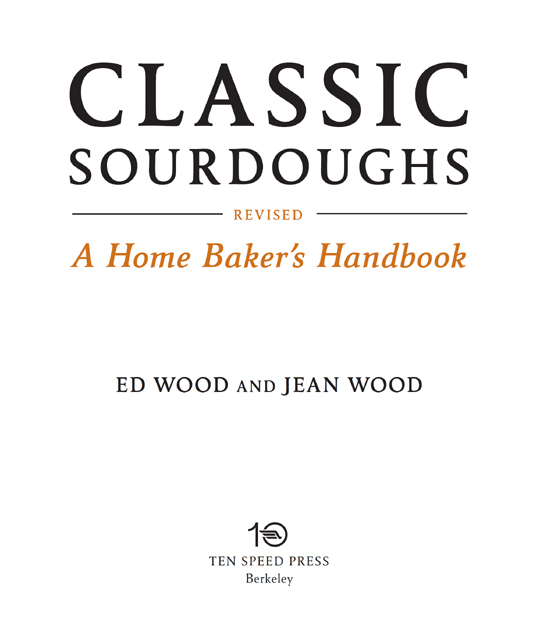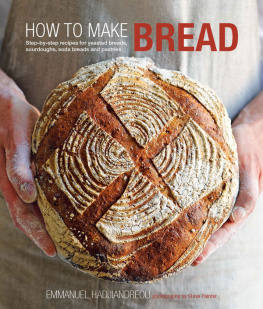Ed Wood - Classic Sourdoughs, Revised
Here you can read online Ed Wood - Classic Sourdoughs, Revised full text of the book (entire story) in english for free. Download pdf and epub, get meaning, cover and reviews about this ebook. year: 2011, publisher: Random House Inc., genre: Home and family. Description of the work, (preface) as well as reviews are available. Best literature library LitArk.com created for fans of good reading and offers a wide selection of genres:
Romance novel
Science fiction
Adventure
Detective
Science
History
Home and family
Prose
Art
Politics
Computer
Non-fiction
Religion
Business
Children
Humor
Choose a favorite category and find really read worthwhile books. Enjoy immersion in the world of imagination, feel the emotions of the characters or learn something new for yourself, make an fascinating discovery.

- Book:Classic Sourdoughs, Revised
- Author:
- Publisher:Random House Inc.
- Genre:
- Year:2011
- Rating:3 / 5
- Favourites:Add to favourites
- Your mark:
- 60
- 1
- 2
- 3
- 4
- 5
Classic Sourdoughs, Revised: summary, description and annotation
We offer to read an annotation, description, summary or preface (depends on what the author of the book "Classic Sourdoughs, Revised" wrote himself). If you haven't found the necessary information about the book — write in the comments, we will try to find it.
Classic Sourdoughs, Revised — read online for free the complete book (whole text) full work
Below is the text of the book, divided by pages. System saving the place of the last page read, allows you to conveniently read the book "Classic Sourdoughs, Revised" online for free, without having to search again every time where you left off. Put a bookmark, and you can go to the page where you finished reading at any time.
Font size:
Interval:
Bookmark:


Copyright 2011 by Ed Wood and The Estate of Jean Wood
Copyright 1989, 1996, 2001 by Ed Wood
All rights reserved.
Published in the United States by Ten Speed Press, an imprint of the Crown Publishing Group,
a division of Random House, Inc., New York.
www.crownpublishing.com
www.tenspeed.com
Ten Speed Press and the Ten Speed Press colophon are registered trademarks of Random House, Inc.
Originally published as World Sourdoughs from Antiquity by Sinclair Publishing, Cascade, ID, in 1996. A revised edition was published by Ten Speed Press, Berkeley, in 1996, and reissued in slightly different form as Classic Sourdoughs: A Home Bakers Handbook by Ten Speed Press, Berkeley, in 2001.
Library of Congress Cataloging-in-Publication Data
Wood, Ed, 1926
Classic sourdoughs : a home bakers handbook / by Ed Wood and Jean Wood. Rev. ed.
p. cm.
Summary: This authoritative sourdough baking classic is updated with a new technique that allows the baker to control sourness and ensure consistently leavened loaves
Provided by publisher
1. Cooking (Sourdough). 2. Sourdough bread. 3. Bread. 4. Cookbooks.
I. Wood, Jean, 1928-2010. II. Title.
TX770.S66W66 2011
641.815dc22
2011009408
eISBN: 978-1-60774-045-2
v3.1

JEAN WOOD
October 21, 1928 October 12, 2010
THIS BOOK IS dedicated to Jean, the coauthor of this book. We met on the campus of Oregon State University in 1948. In the decades since, she has been my companion in every aspect of my lifethe soul of my aspirations.
We married in Boston on June 12, 1950. She brought us three sons and two daughters. As we raised our family, we also shared a lifetime of adventures. We especially loved the outdoors, catching salmon together along the West Coast, hunting for game birds throughout the United States and Canada, and enjoying camping and exploration.
She shared my obsession with sourdough breads and together we searched the Middle East and Europe for the sourdough culture that produced mans first leavened breads. Among ancient bakeries unearthed in Egypt, we discovered the culture that was used to feed the builders of the Giza pyramid.
Jean was loved by all who knew her. Her passion and conviction infuse the writing of this book. Shortly after its completion, she passed from us suddenly and without warning. In loving memory, I dedicate this book to her life and the vitality she brought to mine.
The Birth and Life of Sourdough
The Ingredients of Sourdough Bread
Putting It All Together
Recipes
Baking Sourdoughs with Bread Machines
PEOPLE AROUND THE world are again becoming fascinated by sourdoughs. We see evidence of this interest daily here at Sourdoughs International, where we grow, harvest, and dry cultures that we have collected from around the world (see for descriptions of the cultures in our collection, and the stories behind them). Orders for these cultures come from places as disparate as South Africa, Japan, Australia, and Norway.
Why the fascination? The simple answer is that, in many ways, sourdoughs improve the quality of our lives. They have a unique, inherent charisma, and they still produce the best bread the world has ever known. They are soul-satisfying and fun: we call them endorphins of the kitchen. They truly offer an extension of a personal quality beyond what we eat to what we do and what we are.
More than thirty years ago, we self-published World Sourdoughs from Antiquity. In 1996, it was revised and published by Ten Speed Press, which did a much better job with it than we did. In 2001, it was again revised and updated, this time under the title Classic Sourdoughs: A Home Bakers Handbook. Ten years later, this new edition keeps the heart of the previous editions and adds many refinements in technique and one important new method, the culture proof, which is designed to bring your refrigerated sourdough culture to vibrant life before you begin to bake, ensuring the best structure and flavor in the finished loaf.
This way of baking has enriched our lives tremendously. The purpose of this book is the same as it has been for the last three decades: to share with you the pleasures of using sourdoughs in your own kitchen.
THIS BOOK WILL introduce you to the personal satisfaction and sense of accomplishment experienced by home bakers of traditional sourdough. If you are an experienced sourdough baker, it will guide you to the sourdoughs you seek.
Lets start by defining what we really mean by traditional sourdoughs. We know the sourdough process results from the fermentation reactions of two quite different classes of microorganisms: wild yeast and beneficial bacteria. For well over five thousand years, all breads were produced by the fermentation of these two essential microorganisms acting together. The yeasts are primarily responsible for leavening and bread texture, the bacteria for the sourdough flavor. Thus the definition of traditional sourdough requires a culture, or starter, containing both of these organisms.
Delicious, nutritious breads of various kinds were produced for centuries by a process no one understood. Bakers believed there was something in dough that made it rise. They knew if they saved some old dough and added it to a new batch, the new dough would also rise. For eons, all new doughs required a bit of old dough to start the rising process. In villages and towns around the world, bread was the staff of lifeit literally supported life. People baked it in their homes, and every town had a bakery where the people could take their dough to be baked in the bakers oven, or buy bread from the baker himself. When people emigrated to the United States, they brought their dough starters with them. The California forty-niners and the Yukon and Alaskan miners get credit for the term sourdoughs, probably due to the extreme flavor of their breads (the crusty miners themselves subsequently became known as sourdoughs). Thus our definition of traditional sourdough also requires a culture with organisms that, with proper care, will survive and replicate themselves forever.
In the 1800s, Louis Pasteur looked into a microscope and saw what we now call wild yeast, discovering for the first time what really made bread dough rise. Within the next hundred years, researchers learned how to select, isolate, and grow single strains of yeast in pure cultures. They searched for and found species of Saccharomyces cerevisiae, bakers yeast, which leavened bread doughs with incredible speed.
Then industry took bread out of the home and put it in factories that manufacture something labeled bread, which neither looks nor tastes like the staff of life. Breads began to be produced by mammoth machines. Sourdough starters were no longer used, small-town bakeries disappeared, people stopped baking in their homes, and the staff of life became neither delicious nor nutritious. Bakers thought the need for sourdough cultures was gone forever, but they were wrong. Bakers yeast is totally incapable of producing sourdough flavor, and without the action of lactobacilli in concert with yeast, the quality of breads has never been the samenot even close.
Font size:
Interval:
Bookmark:
Similar books «Classic Sourdoughs, Revised»
Look at similar books to Classic Sourdoughs, Revised. We have selected literature similar in name and meaning in the hope of providing readers with more options to find new, interesting, not yet read works.
Discussion, reviews of the book Classic Sourdoughs, Revised and just readers' own opinions. Leave your comments, write what you think about the work, its meaning or the main characters. Specify what exactly you liked and what you didn't like, and why you think so.











